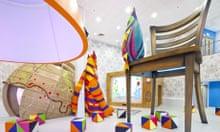Ever wondered how Moses felt as he divided the waters of the Red Sea?
Well, wonder no longer, as you too can now control the elements and part a deluge of torrential rain in the Barbican's Curve gallery. The latest work by a young experimental practice, Random International, Rain Room invites brave visitors to enter a hundred-square-metre downpour, without getting in the slightest bit wet.
Set on a raised plinth at the end of the dark, curving corridor space, powerfully backlit by a glaring spotlight, the perfectly rectangular chunk of rain appears transposed from a parallel place, with the precision of a carefully staged experiment.
As visitors step up on to the stage, these identical vertical lines of driving rain begin to be repelled, as if each body is giving off a kind of invisible magnetic field. As you step further in, the rain closes around you, enveloping each silhouetted figure in a perfect cylindrical void. It is a startlingly surreal experience.
The apparently simple trick is the result of a lengthy period of development, which came out of playing with large-format printing.
"We started three years ago, testing temporary 'printing' with water, spraying droplets from above, like a long-distance ink-jet printer," says Florian Ortkrass, who founded Random International with fellow Royal College of Art design graduates Stuart Wood and Hannes Koch in 2005.
"But we became much more interested in how people would react to the piece," he explains. "It's the same with all of our work: it doesn't make sense without anyone there."
Their first piece involving participation was Audience (2008), a disconcerting field of mirrors that eerily turned to follow visitors as they walked between them, making the viewer both the active agent and subject of the piece. Two years later, their Swarm installation translated the collective behaviour of a flock of birds into moving light. The sound of visitors stimulated the "collective consciousness" of a network of suspended LEDs, causing dynamic waves of light to ripple through the space.
The group treats each project as part of an ongoing process of research into the relationship between people and new intelligent technologies, and has been working with the cognitive scientist Philip Barnard to analyse people's behaviour.
"The best bit is watching what people do," says Ortkrass. "It's either totally crazy, or utterly banal, but never what we're expecting."
Behind the magic of each piece is a highly refined piece of technology. The Rain Room is controlled by a series of cameras that 3D-map the location of bodies on the plinth, translating this to a pixelated grid of 25cm x 25cm panels, each of which controls nine outlets – and a total of 2,500 litres of water, falling at a rate of 1,000 litres per minute, which is filtered, treated and recycled.
The piece will play host to performances choreographed by Wayne McGregor, with music scored by Max Richter, to be premiered during the Frieze Art Fair.


